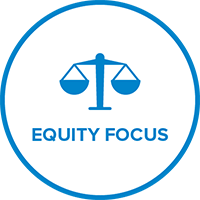Overview
Highline Public Schools continually embeds equity across all of their practices, including within the language they use to describe students, with the goal of disrupting institutional biases and ending inequitable systems in their schools. These practices are grounded in the Highline Promise – to know every student “by name, strength and need.” To ensure all community members think and talk about students holistically – based on their assets and not deficits – Highline has built a culture of using student-first and strength-based language (often referred to as asset-based language).
“How we talk to, with, and about our children matters. It dawned on me in a meeting a few years ago that some of my colleagues in high-poverty, highly impacted districts almost use the challenge that students and families face as a badge of honor, when in fact it’s a reductionist label that undermines the brilliance and resilience of our kids.” – Dr. Susan Enfield, Highline Public Schools Superintendent
Through its commitment to equity and strong alignment from leadership, the district has developed the foundations to engage in meaningful conversations and develop the capacity to advance equity. By focusing on asset-based, student-first language, educators internalize positive narratives focused on community strengths, contributions, and aspirations – rather than challenges and deficits.
"I've appreciated aligning Highline’s core values with external partners, like i-Ready. They have worked with us to shift their language when working with school and district staff by listening to our story. This has included their 30+ trainers who work with schools to ensure that, when talking about student results and instructional planning, their mindset and language are strength-based." – Rebekah Kim, Executive Director of Teaching, Learning and Leadership

Educators
Break habits and reframe dialogue using human-first, strength-based language.
Support and hold colleagues accountable and provide feedback when encountering any deficit-based language.
School and System Leaders
Model strength-based language and provide professional learning opportunities (e.g., coaching, DEI sessions) to build educator capacity and understanding.
Align official resources (e.g., guides, data reports) to ensure consistent use of strength-based language.
Push service providers and community partners to use aligned language.
Community Partners
Reframe all language and narratives to align with asset-based framing.
Reflect on the intentions and impacts of deficit-based language.
This strategy is a part of TLA's Hop, Skip, Leapfrog release, which explores the concrete ways in which schools and systems pursued student-centered innovation during COVID-19. Explore the full guide to find additional strategies, insights, and resources.

Equity Focus
An asset-based approach shifts language and mindsets away from deficit-based models, ensuring educators and systems do not only attribute individuals with their deficits. Aligning language ensures that educators and community members are intentional when referring to various populations, also changing the mindsets around how we think about students and communities furthest from justice.
